Researchers Develop Innovative Nanocardboard for Atmospheric Exploration
In a groundbreaking study, researchers have created a novel material known as nanocardboard, showing promise for atmospheric exploration, particularly in the mesosphere—a challenging layer of Earth’s atmosphere. This lightweight material demonstrates potential applications in environmental studies and space exploration, marking a significant step forward in the field of aerospace science.
Lightweight Innovation
The nanocardboard, primarily composed of chromium, aluminum, and aluminum oxide, is exceptionally lightweight, weighing only one gram per square meter. When exposed to light sources such as lasers or white LED lights, the material generates measurable thrust, outpacing its own weight. This remarkable feat underscores the effectiveness of utilizing a relatively obscure physical effect to achieve levitation. According to one of the researchers, "It’s a really nice demonstration that we can take a relatively obscure and weak physical effect and design devices that can levitate in the upper atmosphere, powered by nothing more than sunlight—which is pretty cool."
Challenges in the Mesosphere
Despite the encouraging results, the mesosphere remains a particularly challenging zone for atmospheric research. Located between the stratosphere and the thermosphere, it lacks sufficient density to support traditional aircraft or balloons, yet possesses enough gas to pose risks to satellites. Researchers aim to convert these nanocardboard materials into instrument-carrying aircraft that could operate within this elusive atmospheric layer.
However, this ambition faces significant hurdles. Incorporating the structural components necessary to hold scientific instruments into the lightweight design presents a major engineering challenge. The nanocardboard generates limited lift, even in optimal conditions within the mesosphere, complicating efforts to design a functional vehicle.
Deployment Difficulties
Getting these devices into the upper stratosphere presents another layer of complexity. The nanocardboard cannot generate adequate lift within the denser lower atmosphere, requiring a secondary method for initial transport. This could involve using a larger balloon or vehicle to elevate the device before a gentle release, safeguarding its fragile structure. Additionally, unless deployed during the polar summer, the devices may descend back during nighttime due to the lack of sunlight, raising questions about their viability for extended atmospheric missions.
Future Potential and Acknowledgements
While the researchers face several daunting challenges, they remain optimistic about the potential applications of nanocardboard technology. They even envision its use beyond Earth, suggesting it could be adapted for atmospheric exploration on Mars. This idea, while exciting, raises further questions about practical implementation and the physical realities of extraterrestrial environments.
Despite the complexities involved, the creation of nanocardboard represents a noteworthy advancement in material science and physics. Even if the ambitious visions of atmospheric vehicles do not materialize as planned, the fundamental discoveries from this research hold significant value for future experiments and may inspire more breakthroughs in aerospace technology.
Conclusion
The development of nanocardboard for atmospheric exploration highlights the innovative spirit of contemporary scientific research. With promising applications and intriguing challenges, the work lays a foundation for future studies aimed at unraveling the mysteries of our atmosphere and beyond. As researchers continue to explore the potential of lightweight materials, the possibility of revolutionizing how we study both Earth and other celestial bodies remains on the horizon.









